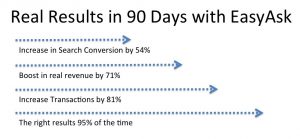July is “Best Practices” month here at EasyAsk – where we describe good search, navigation and merchandising techniques that can help you convert more customers. As you and your teams ramp up for busy back-to-school and holiday seasons, we want to help you convert more visitors into sales. Over the course of this month, our team will show different best practices in search, navigation and merchandising and how they can impact customer experience.
While EasyAsk has many lessons to share, we always like to recognize best practices from independent firms, especially when they align with our vision. Gartner, a preeminent research firm, recently released a report called “Best Practices in Strategically Combining Search, Content Analytics and E-Commerce“, written by Whit Andrews and Gene Alvarez – two of the brightest minds in e-commerce and search.
Among the findings in this report, the Gartner analysts clearly stated the value of search, navigation and merchandising to an e-commerce environment:
- Search is the means by which shoppers most nakedly reveal their needs and wants (as they themselves perceive them) to sellers.
- Search is, therefore, a particularly powerful way to promote, relate and reveal products in a shopping experience.
The analysts went on from there to lay out two very important best practices in e-commerce search:
- Offer Effective Definition-Matching and Handling of Ambiguity in Query Terms
- Use Search and Content Analytics to Fulfill Shoppers’ Desires Through Merchandise, Related and Suggested Offers, and Advertising
These two best practices highlight the unique advantages natural language technology delivers in an e-commerce search environment. Since natural language understands both the intent of the search and the content being searched, visitor searches are more accurately matched and the search engine seamlessly deals with ambiguity – misspellings, tenses, stemming and when to relax terms. Natural language also understands the relationship between terms in a search to derive contextual meaning and further eliminates ambiguity.
In addition, the actionable analytics and natural language business rules in EasyAsk make it easy for your business people to better merchandise your site with context-driven offers, promotions and ads.
In the next two blog posts of this series, I will drill down into each of the two Gartner best practices we discussed above. I will examine the best practices, detail how natural language fulfills the promise of these best practices and show customer sites where these practices are applied.
The most valuable best practices typically come from experts that have visibility into the widest spectrum of implementations – learning how smart people across the industry approach problems differently. We’re always happy to confirm when EasyAsk best practices match those of top-tier research firms, such as Gartner.


 The world we know continues to change, and we as a people, are forced to change with it. Sometimes it’s in small ways, like swapping Bell Bottoms for White-Washed jeans, then swapping those for Skinny Jeans. Sometimes it’s in larger ways, like going from hailing a cab on the sidewalk, to ordering an Uber from your bedroom/office/etc. with a touch of a button. Some of us prefer the former, while others have adapted, or were even raised with the latter. It is those inbred traits from our particular generation that make us who we are. The beauty of today’s age is that our technology can handle whichever you prefer. Can your
The world we know continues to change, and we as a people, are forced to change with it. Sometimes it’s in small ways, like swapping Bell Bottoms for White-Washed jeans, then swapping those for Skinny Jeans. Sometimes it’s in larger ways, like going from hailing a cab on the sidewalk, to ordering an Uber from your bedroom/office/etc. with a touch of a button. Some of us prefer the former, while others have adapted, or were even raised with the latter. It is those inbred traits from our particular generation that make us who we are. The beauty of today’s age is that our technology can handle whichever you prefer. Can your 